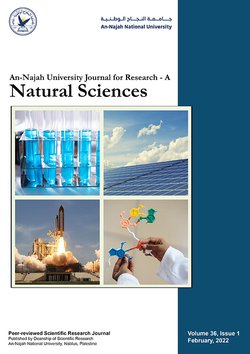Comparative analysis of interpolation methods for rainfall mapping in the Faria catchment, Palestine
Article info
2021-02-08
2021-12-28
1 - 20
Keywords
- Palestine
- Rainfall
- Interpolation;
- Distribution;
- Spatial
- Catchment;
- Faria
Abstract
The availability of rainfall data is essential for the prediction of extreme rainfall events, hydrological modeling, and the design of water resources systems. In Palestine, the limited available rain gauges and the available rainfall data are insufficient to precisely characterize the areal rainfall distribution over the entire area. Hence, it is essential to find proper methods to utilize the available rainfall data at the existing raingauges to predict rainfall values at certain locations where rainfall measurements are not available. This study aims at identifying the most suitable interpolation method that can be used to produce interpolated rainfall surfaces at the Faria catchment, Palestine. Faria catchment (320 km2), located in the northeastern part of the West Bank, Palestine, is characterized by high temporal and spatial rainfall variations. Six, GIS-based, spatial interpolation methods have been tested by visual observation and cross-validation. These methods are: Inverse Distance Weighted, Spline completely Regularized, Spline with Tension, Ordinary Kriging, Universal Kriging, and Regression. Available seasonal rainfall data recorded at 16 locations for two rainy seasons; 2016/2017 and 2017/2018 were utilized. Results indicate that the Universal Kriging method has slightly a higher correlation coefficient and lower mean relative error than the other methods for the two seasons that make the method the most optimal one for mapping rainfall distribution in the Faria catchment. Moreover, the spatial distribution of raingauges between the two seasons affects the performance of different interpolation methods in the catchment.
Shadeed, S., Jayyousi, A., Khader, A., Chwala, C., & Kunstmann, H. (2022). Comparative analysis of interpolation methods for rainfall mapping in the Faria catchment, Palestine. An-Najah University Journal for Research - A (Natural Sciences), 36(1), 1–20. https://doi.org/10.35552/anujr.a.36.1.2000
[1]S. Shadeed, A. Jayyousi, A. Khader, C. Chwala, and H. Kunstmann, “Comparative analysis of interpolation methods for rainfall mapping in the Faria catchment, Palestine,” An-Najah University Journal for Research - A (Natural Sciences), vol. 36, no. 1, pp. 1–20, Feb. 2022, doi: 10.35552/anujr.a.36.1.2000.
Shadeed, Sameer, et al. “Comparative Analysis of Interpolation Methods for Rainfall Mapping in the Faria Catchment, Palestine.” An-Najah University Journal for Research - A (Natural Sciences), vol. 36, no. 1, Feb. 2022, pp. 1–20. Crossref, https://doi.org/10.35552/anujr.a.36.1.2000.
1.Shadeed S, Jayyousi A, Khader A, Chwala C, Kunstmann H. Comparative analysis of interpolation methods for rainfall mapping in the Faria catchment, Palestine. An-Najah University Journal for Research - A (Natural Sciences) [Internet]. 2022 Feb;36(1):1–20. Available from: http://dx.doi.org/10.35552/anujr.a.36.1.2000
Shadeed, Sameer, Anan Jayyousi, Abdelhaleem Khader, Christian Chwala, and Harald Kunstmann. “Comparative Analysis of Interpolation Methods for Rainfall Mapping in the Faria Catchment, Palestine.” An-Najah University Journal for Research - A (Natural Sciences) 36, no. 1 (February 2022): 1–20. https://doi.org/10.35552/anujr.a.36.1.2000.
Comparative analysis of interpolation methods for rainfall mapping in the Faria catchment, Palestine
معلومات المقال
2021-02-08
2021-12-28
1 - 20
الكلمات الإفتتاحية
- Palestine
- Rainfall
- Interpolation;
- Distribution;
- Spatial
- Catchment;
- Faria
الملخص
The availability of rainfall data is essential for the prediction of extreme rainfall events, hydrological modeling, and the design of water resources systems. In Palestine, the limited available rain gauges and the available rainfall data are insufficient to precisely characterize the areal rainfall distribution over the entire area. Hence, it is essential to find proper methods to utilize the available rainfall data at the existing raingauges to predict rainfall values at certain locations where rainfall measurements are not available. This study aims at identifying the most suitable interpolation method that can be used to produce interpolated rainfall surfaces at the Faria catchment, Palestine. Faria catchment (320 km2), located in the northeastern part of the West Bank, Palestine, is characterized by high temporal and spatial rainfall variations. Six, GIS-based, spatial interpolation methods have been tested by visual observation and cross-validation. These methods are: Inverse Distance Weighted, Spline completely Regularized, Spline with Tension, Ordinary Kriging, Universal Kriging, and Regression. Available seasonal rainfall data recorded at 16 locations for two rainy seasons; 2016/2017 and 2017/2018 were utilized. Results indicate that the Universal Kriging method has slightly a higher correlation coefficient and lower mean relative error than the other methods for the two seasons that make the method the most optimal one for mapping rainfall distribution in the Faria catchment. Moreover, the spatial distribution of raingauges between the two seasons affects the performance of different interpolation methods in the catchment.
Shadeed, S., Jayyousi, A., Khader, A., Chwala, C., & Kunstmann, H. (2022). Comparative analysis of interpolation methods for rainfall mapping in the Faria catchment, Palestine. An-Najah University Journal for Research - A (Natural Sciences), 36(1), 1–20. https://doi.org/10.35552/anujr.a.36.1.2000
[1]S. Shadeed, A. Jayyousi, A. Khader, C. Chwala, and H. Kunstmann, “Comparative analysis of interpolation methods for rainfall mapping in the Faria catchment, Palestine,” An-Najah University Journal for Research - A (Natural Sciences), vol. 36, no. 1, pp. 1–20, Feb. 2022, doi: 10.35552/anujr.a.36.1.2000.
Shadeed, Sameer, et al. “Comparative Analysis of Interpolation Methods for Rainfall Mapping in the Faria Catchment, Palestine.” An-Najah University Journal for Research - A (Natural Sciences), vol. 36, no. 1, Feb. 2022, pp. 1–20. Crossref, https://doi.org/10.35552/anujr.a.36.1.2000.
1.Shadeed S, Jayyousi A, Khader A, Chwala C, Kunstmann H. Comparative analysis of interpolation methods for rainfall mapping in the Faria catchment, Palestine. An-Najah University Journal for Research - A (Natural Sciences) [Internet]. 2022 Feb;36(1):1–20. Available from: http://dx.doi.org/10.35552/anujr.a.36.1.2000
Shadeed, Sameer, Anan Jayyousi, Abdelhaleem Khader, Christian Chwala, and Harald Kunstmann. “Comparative Analysis of Interpolation Methods for Rainfall Mapping in the Faria Catchment, Palestine.” An-Najah University Journal for Research - A (Natural Sciences) 36, no. 1 (February 2022): 1–20. https://doi.org/10.35552/anujr.a.36.1.2000.

Since 2019
Cite Score (Scopus): 0.5
Time to First Decision: 3 Days
Submission to Acceptance: 64 Days
Acceptance to Publication: 10 Days
Acceptance Rate: 28%
Call for Papers:
Sustainable Materials and Chemistry for Energy and Environmental Applications
Why should you
Publish With Us?
An-Najah National University
Nablus, Palestine
Nablus, Palestine
- P.O. Box
- 7, 707
- Fax
- (970)(9)2345982
- Tel.
- (970)(9)2345560
- (970)(9)2345113/5/6/7-Ext. 2628
- [email protected]
- EIC
- Prof. Waleed Sweileh
An-Najah University Journal for Research - A (Natural Sciences) by An-Najah University, Nablus, Palestine is licensed under CC BY-NC 4.0

